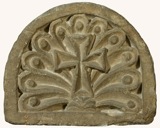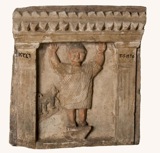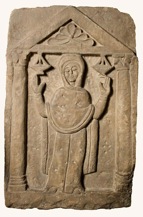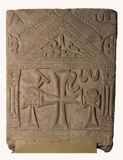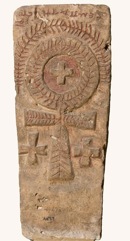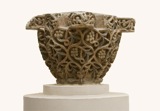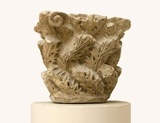Lintel
with acanthus scrolls enclosing animals and human
busts
Inv. No. 7381
Limestone, H: 40 cm, L: 135 cm
Saqqara, Monastery of St. Jeremiah, 6th / 7th
century
A Latin cross is set in the centre of this beautifully
carved frieze. Acanthus scrolls to either side of the cross
enclose human busts, an antelope and a lion. Along the
lower edge of the block is a Coptic inscription which is a
dedication of Victor and his son Shoi.
Relief with a
cross
Inv. No. 6529
Limestone
H: 27 cm, W: 32 cm
Unknown provenance, 7th century
This semi-circular stone is decorated with a cross set
against a pearl-studded shell. In Christianity the shell in
combination with the cross symbolize rebirth and
resurrection. The original context of the stone is not
known, but most probably originates from a church.
Relief
with a crown flanked by two
eagles
Inv. No.: 4619
Limestone
H: 32 cm, W: 44 cm
Unknown provenance, 7th century
Since ancient times the eagle has been a symbol of majesty
and triumph. In the Christian context, it symbolizes the
resurrection and is also associated with the evangelist St.
John. The symmetrical order of the two eagles is a
characteristic feature in Coptic art. A wreath-like crown
in the centre of the relief stands as an emblem for
victory.
Gravestone
Inv. No. 12346
Limestone
H: 29 cm, W: 26 cm
Terenouthis, 3rd century
The gravestones from Terenouthis were crafted for a
community adhering to pre-Christian beliefs. A typical
feature is the intermingling of Pharaonic and Greco-Roman
elements. This example shows the deceased in Greek dress.
He stands within an architectural structure whose roof is
formed by a frieze of cobras, first used in the funerary
precint of Pharaoh Djoser in Saqqara. The Pharaonic god
Anubis, here in the shape of a jackal, accompanies the
deceased to safely reach the afterlife.
Gravestone
Inv. No. 8703
Limestone
H: 77 cm, W: 52 cm
Unknown provenance, 5th century
Coptic gravestones often depict the deceased with their
hands raised in prayer. This example was made for a woman
who is dressed in a long garment. A traditional Roman
mantle covers her head and shoulders and hangs down over
her elbows. The deceased stands within an architectural
structure of columns and a pediment decorated with a shell.
Lamps suspended from the pediment above the woman’s hands
relate to a chapel or church.
Capital
with relief from a pilaster
Inv. No. 6471
Limestone
H: 34 cm, W: 72 cm
Unknown provenance, 4th century
Dionysus, the Greek god of wine, occupies the centre of the
scene. He is depicted naked apart from high boots and a
cloak around his shoulders and left arm. With his left
elbow he leans against a pedestal, his right arm is raised
above his head. Dionysus is frequently accompanied by a
panther at his feet. To the left a bearded figure is
rendered in female clothes and a drinking horn in his left
hand. He can probably be identified as Heracles, the most
famous of all Greek heroes. One story about Heracles has
him exchanging clothes with his wife. The tipsy hero is
supported by a male companion. A female follower of
Dionysus stands at the right edge of the slab. Grapevines
evoke the joyful atmosphere of the entire scene. Dionysian
patterns were much favoured in Coptic art.
Pediment
Inv. No. 7044
Limestone
H: 40 cm, W: 115 cm
Probably from Ahnas, 4th century
Reliefs with Greek-mythological themes adorned the facades
of tombs in Heracleopolis Magna (Ahnas) built for a
non-Christian community. This broken pediment is decorated
with Pan, the god of the woods, chasing a frenzied
priestess of Dionysus, the god of wine, holding clappers in
both hands. Pan’s typical features are goat’s feet and
horns sticking out of his hair. A drapery blowing around
his neck signals his frantic speed. Wild lions and an
acanthus interlace frame the scene.
Tombstone of
Plenis
Inv. No. 8585
Sandstone
H: 67 cm, W: 61 cm
Unknown provenance, 6th century
Tombstones from the early years of Christianity are often
decorated with an architectural structure symbolizing the
house of God. Various Christian symbols fill the lower part
of this gravestone. In the centre is Christ’s monogram,
comprising the two Greek letters “Chi” and “Rho”. This
monogram is the most common symbol of Jesus along with the
cross and fish. Here it is flanked by looped crosses (crux
ansata), formerly the Egyptian Hieroglyph “Ankh” (the key
of life), and the first and last letter of the Greek
alphabet “Alpha” and “Omega”, evoking eternity. All of
these Christian signs are framed by fluted columns. Two
leaves and a Greek inscription are set inside the pediment.
The inscription gives the deceased’s name, the date of his
death and expresses the wish that he may “rest in peace”.
Tombstone
Inv. No. 8566
Sandstone
El-Badary (Assiut), 6th century
This gravestone is carved with a looped cross, formerly the
Egyptian “Ankh” (the Pharaonic key of life). It is
decorated with a wreath-like pattern and flanked by Greek
crosses. Another Greek cross is set inside the loop which
is surrounded by a palm branch, which symbolises victory.
Capital
with vine leaves and bunches of
grapes
Inv. No. 8260
Limestone
H: 40 cm
Saqqara, Monastery of St. Jeremiah, 6th century
This basket-like capital is a masterpiece of Coptic
sculpture and exemplifies the outstanding skills of Coptic
artists. It is decorated with interwining vines, tendrils,
leaves and bunches of grapes, evoking the sacrifice of
Christ and the Eucharist. There are faint traces of color,
red on the vines and brown on the leaves. The four
projecting corners of the abacus are covered with foliage.
In its centre heart-shaped tendrils surround a bunch of
grapes and a single leaf.
Capital
decorated with wind-blown acanthus
leaves
Inv. No. 7978
Limestone
H: 43 cm
Saqqara, Monastery of St. Jeremiah, 6th century
The Coptic culture has yielded a great number of finely
carved capitals. This example is exceptional in its design.
It is decorated with acanthus leaves as if they were
blowing in the wind. On all of the capital’s four sides, at
the upper edge, a Greek cross is set inside a wreath.

